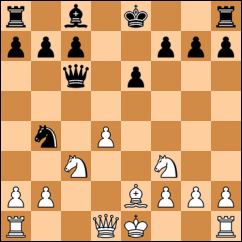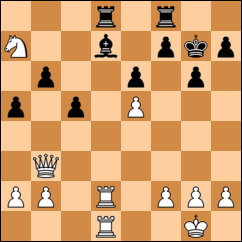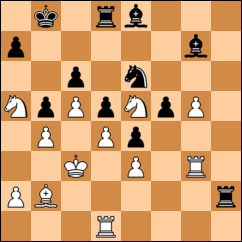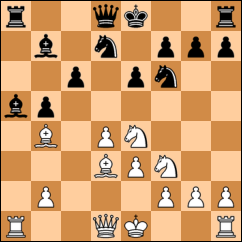First, an easy one for the kids.
K.Ammann–S.Prue
Route 20 Chess Club
Freeport, Ill., Sept. 21, 2010
White to move. (Highlight to reveal answer.)
1.Bb5 0-0 2.Bxc6 Nxc6
Now for something more challenging:
White to move. (Highlight to reveal answer.)
1.Nc6! Bxc6 2.Rxd8 Bd5 3.Qxb6
J.Carter–K.Ammann
Route 20 Chess Club
Freeport, Ill., Sept. 21, 2010
Black to move. (Highlight to reveal answer.)
1...Bxe5 2.dxe5 d4!
This sets off a complicated chain of variations. White's best response is 2.Rxd4 Nxd4, but caution is required, because if white doesn't play 3.exd4, then 3...Rc2# is immediate mate, while 3...Rg2 and 3...Nxc6+ merely prolong the inevitable.
3.exd4 Rxd4?!
A wise-fool play on my part. I'm thinking about material, but I need to be aware of Jason's passed g-pawn. 2...f4 scores a palpable hit, forcing back the g3-rook (3.Rgg1) and giving me a check (3...Rh3+) which in turn lets me advance my e-pawn as well (4...e3). However, even after 3...Rxd4, black has to walk a tightrope to come out ahead . . .
4.Rxd4 Nxd4 5.g6?? Ne2+ 6.Kc2 Nxg3+
. . . and 5.Kxd4 f4 6.Rg4 Rxb2 7.g6 Bxg6 8.Rxg6 is the only way to avoid falling.
W.Engel–K.Ammann
Route 20 Chess Club
Freeport, Ill., Sept. 21, 2010
White to move. (Highlight to reveal answer.)
1.Nd6 Kf8 2.Rxa5 (≤2.Nxb7+ Bxb4+ 3.Kf1 Qb8 4.Rxa8 Qxa8) 2...Rxa5 (2...Qe7 3.Rxa8+ Bxa8) 3.Nxb7+
A check and a queen-rook fork simultaneously. How articulate would you be after that?








0 comments:
Post a Comment